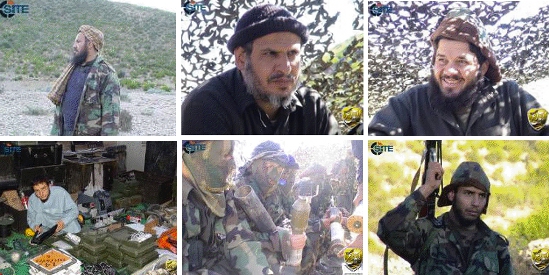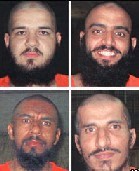
|
|
Top left: Abu Laith al Libi; top center: Abdullah Saad al Libi; top right: Abu Abu Abdullah al Shami; bottom left: Abdul Khabir al Turkistani; bottom center: al Qaeda in the Khorasan fighters; bottom right: Soraqa al Kuwaiti. Images from the SITE Intelligence Group. |
A jihadist media outlet has released “several previously-unreleased” photographs of senior al Qaeda military leaders and fighters who have been killed during fighting in Afghanistan or in US drone airstrikes in Pakistan’s Taliban-controlled tribal agencies.
Pictures of Abu Laith al Libi and Abdullah Said al Libi, two top military commanders; Abu Abdullah al Shami, a leader who escaped from Bagram; and Soraqa
al Kuwaiti and Abdul Khabir al Turkistani, two jihadist fighters, were published on Feb. 4 by the Al Ibda’ Foundation for Media Production. The photographs were published as part of a new series called “Pictures from Khorasan, 1,” according to the SITE Intelligence Group, which provided a translation of the statement along with the photographs.
Abu Laith al Libi
Abu Laith al Libi was a top-tier al Qaeda leader and a revered military commander. He led al Qaeda’s 055 Brigade (or 55th Brigade), the military formation that eventually grew into the Lashkar al Zil, or Shadow Army. Brigade 055 fought alongside the Taliban against the Northern Alliance in the 1990s up until the Sept. 11 2001 attacks on the US. The unit was decimated during the US attack on Taliban and al Qaeda forces in 2001-2002, and was disbanded. Laith reformed the unit, which later became one of six brigades of al Qaeda’s Shadow Army, which operates in Afghanistan and Pakistan.
In addition, Abu Laith was the senior leader of the Libyan Islamic Fighting Group and also served as a chief spokesman for al Qaeda. As leader of the Libyan Islamic Fighting Group, he announced the terror group’s merger with al Qaeda in November 2007.
US Predators and Reapers killed Abu Laith in an airstrike in the Mir Ali area of North Waziristan on Jan. 29, 2008. Al Qaeda announced his death.
Abdullah Said al Libi
Abdullah Said al Libi was a Libyan national who is thought to have served in his country’s military before joining al Qaeda. Once in al Qaeda, he rose in the ranks of the terror group’s military, and eventually took command of the Lashkar al Zil.
In April 2009, Abdullah Said laid out the strategy for al Qaeda and the Taliban to retake control of the Khorasan, a region encompassing large areas of Afghanistan, Pakistan, Uzbekistan, Tajikistan, and Iran. In the statement, he is identified as the leader of the Qaidat al-Jihad fi Khorasan, or the Base of the Jihad in the Khorasan.
Abdullah Said was killed in a US drone strike sometime in late 2009 or early January 2010. Mustafa Abu Yazid, al Qaeda’s former leader of Afghanistan, who was killed in a later drone strike, mentioned his name while noting the deaths of other top al Qaeda leaders. Yazid said the suicide attack on a CIA base in Khost, Afghanistan, which killed seven CIA operatives and employees along with a Jordanian intelligence official, was designed to “avenge” the deaths of Abdullah Said, former al Qaeda operations chief Saleh al Somali, and former Pakistani Taliban leader Baitullah Mehsud.
|
|
|
The Bagram Four: Abu Abdallah al Shami [upper left]; Abu Nasir al Qahtan [upper right]; Abu Yahya al Libi [lower left]; Omar al Farouq [lower right]. |
Abu Abdullah al Shami
Abu Abdallah al Shami was a Syrian national who served as a senior military commander in eastern Afghanistan. He was one of four senior al Qaeda operatives who escaped from Bagram prison on July 10, 2005. Al Qaeda said that al Shami was killed in a US airstrike in Afghanistan sometime in July 2008.
Al Shami escaped from Bagram with top al Qaeda leaders Abu Yahya al Libi, Abu Nasir al Qahtani, and Omar Farouq. Of the four, only Abu Yahya remains free. Yahya is now considered to be al Qaeda’s second in command, following the death of Atiyah al Libi in a US airstrike in Pakistan last fall.
British special forces killed Omar Farouq in Basrah, Iraq, in September 2006 after he tried to be reassigned to facilitate the flow of money, weapons, and fighters for al Qaeda in Iraq. Prior to his capture by Indonesian security forces in 2002, Farouq was considered to be al Qaeda’s point man in Southeast Asia. In 1994, he helped set up the first al Qaeda training camp in Southeast Asia, in Mindanao in the Philippines. Five years later, in 1999, he took credit for bombing both a mosque and the Philippine ambassador’s house in Jakarta.
US forces recaptured Abu Nasir al Qahtani in Khost province in November 2006. Like Shami, Qahtani was a senior al Qaeda military commander in eastern Afghanistan. After his escape from Bagram, Qahtani fled to North Waziristan to continue attacks against NATO and Afghan forces inside Afghanistan. He joined forces with al Qaeda operative Abu Wafa, who operates from the North Waziristan tribal agency in Pakistan. Wafa and Qahtani were active in the Afghan provinces of Khost, Paktia, and Paktika. Qahtani also released propaganda and training videos for terrorists operating in both Afghanistan and Iraq. Qahtani’s brother, Abu Dejana al Qahtani, was also killed in eastern Afghanistan in May 2008.
Abdul Khabir al Turkistani and Soraqa al Kuwaiti
Little is known about Abdul Khabir al Turkistani and Soraqa al Kuwaiti. Al Turkistani is pictured in a room filled with explosives and bomb-making materials. Al Kuwaiti is a “deceased fighter who appeared in the fifth episode of As Sahab’s video series ‘Diaries of a Mujahid,'” according to the SITE Intelligence Group. As Sahab is al Qaeda’s official media production outlet.









6 Comments
But, there is no Central Asian Country called Turkistan. This guy is probably an Uighur Muslim from Xinjiang.
These ‘people’ might want to consider less focus on an antiquital past & pay better attention to the present conditions.
he is presumably from the Central Asian country of Turkistan. East Turkestan is a country but part of China. Turkistan is the region in Asia consisting of mostly Turkic Central Asian States.
Is it just my imagination, or does the middle top picture of the six look just like “The Ugly” (Eli Wallach) in the Clint Eastwood movie, “The Good, the Bad, and the Ugly”?
When will these stupid Islamist nut-jobs learn that eastern Afghanistan and FATA isnt apart of either the modern nor historic Khorasan.
Excellent article and easy to understand explanation. How do I go about getting permission to post part of the article in my upcoming news letter? Giving proper credit to you the author and link to the site would not be a problem.